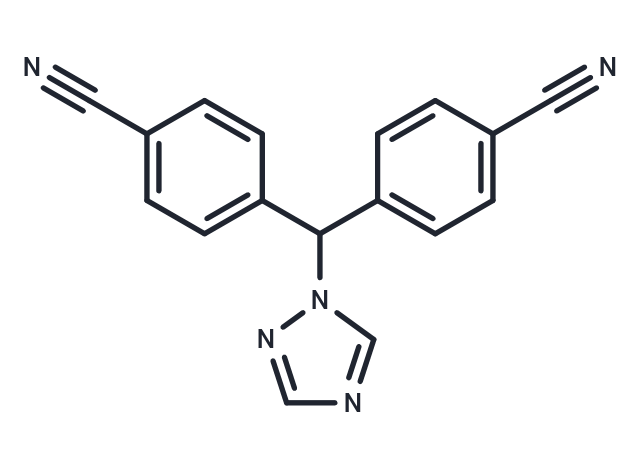Shopping Cart
- Remove All
 Your shopping cart is currently empty
Your shopping cart is currently empty

Letrozole (CGS 20267) is an Aromatase Inhibitor. The mechanism of action of letrozole is as an Aromatase Inhibitor.

| Pack Size | Price | Availability | Quantity |
|---|---|---|---|
| 25 mg | $31 | In Stock | |
| 50 mg | $46 | In Stock |
| Description | Letrozole (CGS 20267) is an Aromatase Inhibitor. The mechanism of action of letrozole is as an Aromatase Inhibitor. |
| Targets&IC50 | Aromatase:0.07 nM-20 nM |
| In vitro | Letrozole exhibits a dose-dependent inhibitory effect on the growth of tumors formed by MCF-7 cells, which have been transfected with the human aromatase gene (MCF-7Ca), in athymic nude mice. It completely inhibits tumor growth at a dosage of 20 mg/kg/day. In vivo studies have demonstrated that Letrozole can suppress aromatase activity, with an oral ED50 of 1-3 μg/mg. |
| In vivo | Letrozole inhibits the production of estradiol in hamster ovarian tissue induced by LH (Luteinizing Hormone), with an IC50 of 0.02 μM, and does not significantly affect progesterone production at concentrations up to 350 μM. In rat adrenal tissue stimulated by ACTH (Adrenocorticotropic Hormone), letrozole suppresses the production of aldosterone, with an IC50 of 210 μM. In non-cellular systems, its IC50 ranges from 1-13 nM. Letrozole effectively inhibits aromatase activity derived from various sources, including human placental microsomes, human breast cancer particulate fractions, rat ovarian microsomes, MCF-7 cells transfected with aromatase, JEG-3 choriocarcinoma cells, CHO (Chinese Hamster Ovary) cells, hamster ovarian tissue, and human breast cancer particulate fractions, with respective IC50 values of 11, 2, 7, 0.07, 0.07, 1.4, 20, and 0.8 nM. |
| Kinase Assay | Human placental aromatase activity: The assay is performed in a total volume of 1 mL at 37 ℃. Unless otherwise noted, the incubation mixture contains 11 nM [4- 14C] androstene-3, 17-dione ([4- 14C]A), 24 mM NADPH (tetrasodium salt Type III), the appropriate concentrations of the desired inhibitor, and 120 μg of microsomal protein. The (4- 14C)A is added as a solution in 1.7% ethanol in 0.05 M potassium phosphate buffer (pH 7.4), so that the final concentration of ethanol does not exceed 0.02% (v/v). The reaction is started by the addition of enzyme and stopped after 20 min by the addition of 7 vol of ethyl acetate. The mixture is agitated on a vortex mixer and centrifuged at 600 g for 5 min. The aqueous phase is re-extracted with 7 vol of ethyl acetate, and the combined extracts are evaporated to dryness using an Evapo-Mix. Over 99% of the radio- active of [4- 14C] added is recovered using this extraction system. The residue obtained is dissolved in 150 μL acetone, and 100 μL aliquots are chromatographed for 65 min on thin-layer plates precoated with silica gel 60 using ethyl: acetate: isooctane (140:60, v/v; system A) or toluene: chloroform: methanol (70:140:20; system B). The radioactive zones of the plate are located with a Berthold LB 2760 thin-layer scanner. The radioactive estradiol (E2) and estrone (E1) neaks are identified by comparison with authentic standards. The corresponding bonding band of silica gel is transferred to vials containing 10 mL of scintillation fluid, and counted with a 6880 Liquid Scintillation system. |
| Cell Research | Cells are seeded in duplicate at 5,000 to 10,000 cells per well in 24-well plates. The day after plating, different concentrations of Letrozole are added. At the end of incubation, cells are trypsinizated and placed in Isotone solution and counted immediately using a Coulter particle-counter. (Only for Reference) |
| Alias | CGS 20267 |
| Molecular Weight | 285.3 |
| Formula | C17H11N5 |
| Cas No. | 112809-51-5 |
| Smiles | N#CC1=CC=C(C=C1)C(N1C=NC=N1)C1=CC=C(C=C1)C#N |
| Relative Density. | 1.21g/cm3 |
| Storage | Powder: -20°C for 3 years | In solvent: -80°C for 1 year | Shipping with blue ice. | |||||||||||||||||||||||||||||||||||
| Solubility Information | DMSO: 50 mg/mL (175.25 mM), Sonication is recommended. | |||||||||||||||||||||||||||||||||||
Solution Preparation Table | ||||||||||||||||||||||||||||||||||||
DMSO
| ||||||||||||||||||||||||||||||||||||

Copyright © 2015-2025 TargetMol Chemicals Inc. All Rights Reserved.